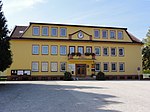Žermanice Reservoir
Buildings and structures in the Moravian-Silesian RegionCieszyn SilesiaCzech building and structure stubsDams completed in 1957Frýdek-Místek District ... and 2 more
Moravian-Silesian Region geography stubsReservoirs in the Czech Republic

Žermanice Reservoir (Czech: vodní nádrž Žermanice) is a water reservoir and dam in Lučina in the Moravian-Silesian Region of the Czech Republic. It was built on the Lučina River in 1951–1957 on an area of 2.48 km2 (0.96 sq mi).The reservoir is named after the village of Žermanice. In addition to Lučina on the western shore and Žermanice on the northern shore, there are also the villages of Dolní Domaslavice and Soběšovice on the eastern shore of the reservoir. The reservoir is a popular spot for water sports and other recreational activities. The reservoir is also used to supply water for factories in Ostrava and Paskov.
Excerpt from the Wikipedia article Žermanice Reservoir (License: CC BY-SA 3.0, Authors, Images).Žermanice Reservoir
okres Frýdek-Místek
Geographical coordinates (GPS) Address Nearby Places Show on map
Geographical coordinates (GPS)
| Latitude | Longitude |
|---|---|
| N 49.719444444444 ° | E 18.461944444444 ° |
Address
ev.33
739 38 okres Frýdek-Místek
Moravia-Silesia, Czechia
Open on Google Maps










